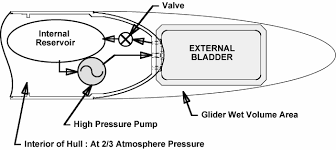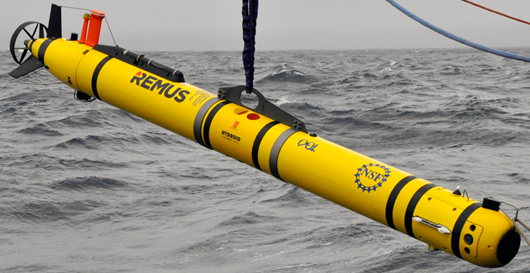Autonomous Underwater Vehicles
Autonomous underwater vehicles (AUVs) are submersible robotic platforms with the ability to travel under water without continuous direction from an operator. AUVs can be equipped with multiple instruments that measure temperature, salinity, pressure, and properties of ocean currents. AUVs may carry devices for passive and active acoustics, such as hydrophones, echosounders, and acoustic doppler current profilers (ADCPs). Acoustics, such as underwater GPS, can also be used for navigation of these vehicles.
While AUVs can be preprogrammed with initial mission parameters, operators may alter their movement and data acquisition pattern. Commands sent by satellite, radio, cellular, or WiFi signal require that the AUV be at the surface However, acoustic communications can be used to send and receive commands when the AUV is under water. Advantages of AUVs are that they can continue operations during bad weather and can stay submerged for extended periods depending on factors such as battery life and data storage capacity. They are also cost effective in that they do not require constant operation or ship time to monitor them.
The collected raw data are stored on hard drives onboard the AUV until the vehicle is recovered. Some AUVs have onboard computational abilities and are able to process large data sets into formats that are transmissible over remote communications.
There are two types of AUVs, buoyancy-driven gliders and propeller-driven vehicles.
Buoyancy-Driven Underwater Gliders
Buoyancy-driven underwater gliders are winged, low-powered AUVs that change their buoyancy by pumping oil from a rigid reservoir inside the vehicle to an external flexible bladder, allowing the glider to ascend or descend.

Alex J Angilella, CC BY 3.0 <https://creativecommons.org/licenses/by/3.0>, via Wikimedia Commons
The wings of the glider help convert this vertical momentum into forward movement. The pitch and roll of the glider are controlled by shifting the position of the internal battery packs. By controlling its buoyancy and pitch, the glider traverses and samples in a sawtooth-like pattern. This allows it to operate for long periods (weeks to months) and over long distances at relatively low energy-cost.
Buoyancy-driven AUVs can be much quieter than propeller-driven AUVs, making them preferable for underwater acoustic data collection. They move slowly, at about 0.50 knots (about 25 cm/s) with little self-generated noise. Hydrophone-equipped gliders can be used to study the spatial and temporal distribution and behavior of aquatic animals, such as baleen whales (Gallagher, 2025).

Deployment of a Slocum glider off the coast of New Jersey, in collaboration with the Rutgers University Center for Ocean Observing Leadership and the New Jersey Department of Environmental Protection, Bureau of Marine Water Monitoring. Credit: New Jersey Department of Environmental Protection.
Propeller-Driven Underwater Vehicles
While gliders are useful in many applications, sometimes underwater vehicles require more maneuverability to conduct an operation. AUVs with propulsion systems can reach higher speeds and are more maneuverable than buoyancy-driven gliders, however they generate more noise. Propeller-driven AUVs can be used to tow acoustic arrays with better maneuverability and navigational control. This provides scientists and engineers with the ability to determine the direction of a sound source using beamforming while performing passive acoustic monitoring. Due to the energy required for propeller use, the vehicles have a shorter battery life. As a result, propeller-driven underwater vehicles are typically used on missions that are only several hours to days long.

The Pioneer REMUS-600 Autonomous Underwater Vehicle. Credit: Sheri N. White, Woods Hole Oceanographic Institution, Coastal Global Scale Nodes.
Additional Links on DOSITS
- Uncrewed Systems
- Acoustic Fish Tags
- Effects of Sound
- Hydrophone/Receiver
- Investigate Marine Animals
- Red Grouper
- Sei Whale
Additional Resources
- WHOI, Baumgartner Lab, Autonomous investigations of baleen whales.
- Teledyne Webb Research, Slocum Glider.
- University of Alaska: Underwater gliders may change how scientists track fish.
- United States Antarctic Program: Using Slocum gliders in Antarctica https://antarcticsun.usap.gov/science/1417/
References
- Baumgartner, M. F., & Fratantoni, D. M. (2008). Diel periodicity in both sei whale vocalization rates and the vertical migration of their copepod prey observed from ocean gliders. Limnology and Oceanography, 53(5part2), 2197–2209. https://doi.org/10.4319/lo.2008.53.5_part_2.2197
- Baumgartner, M. F., & Mussoline, S. E. (2011). A generalized baleen whale call detection and classification system. The Journal of the Acoustical Society of America, 129(5), 2889–2902. https://doi.org/10.1121/1.3562166
- Baumgartner, M. F., Fratantoni, D. M., Hurst, T. P., Brown, M. W., Cole, T. V. N., Van Parijs, S. M., & Johnson, M. (2013). Real-time reporting of baleen whale passive acoustic detections from ocean gliders. The Journal of the Acoustical Society of America, 134(3), 1814–1823. https://doi.org/10.1121/1.4816406
- Calderan, S., Miller, B., Collins, K., Ensor, P., Double, M., Leaper, R., & Barlow, J. (2014). Low-frequency vocalizations of sei whales ( Balaenoptera borealis ) in the Southern Ocean. The Journal of the Acoustical Society of America, 136(6), EL418-EL423. https://doi.org/10.1121/1.4902422
- Gallagher, K.L, Baumgartner M, Kohut J, Miles T, Flagg C, McSweeney JM, Warren JD, Thorne L (2025) Passive acoustic monitoring of baleen whales using autonomous gliders in relation to offshore wind energy areas in the New York Bight. Endang Species Res 58:257-273 https://doi.org/10.3354/esr01452
- Klinck, H., Mellinger, D. K., Klinck, K., Bogue, N. M., Luby, J. C., Jump, W. A., … Baird, R. W. (2012). Near-real-time acoustic monitoring of beaked whales and other cetaceans using a SeagliderTM. PLoS ONE, 7(5), e36128. https://doi.org/10.1371/journal.pone.0036128
- Wall, C., Lembke, C., & Mann, D. (2012). Shelf-scale mapping of sound production by fishes in the eastern Gulf of Mexico, using autonomous glider technology. Marine Ecology Progress Series, 449, 55–64. https://doi.org/10.3354/meps09549